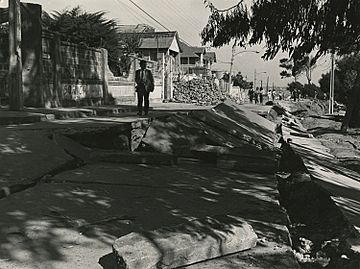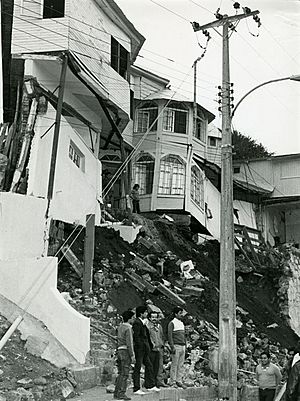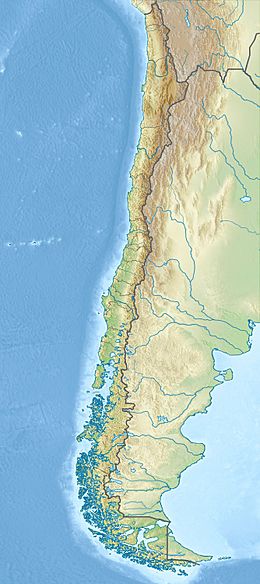1985 Algarrobo earthquake facts for kids
 |
|
| UTC time | 1985-03-03 22:47 |
|---|---|
| ISC event | 529084 |
| USGS-ANSS | ComCat |
| Local date | 3 March 1985 |
| Local time | 19:47 UTC-3 |
| Magnitude | 8.0 Mw |
| Depth | 33.0 km (20.5 mi) |
| Epicenter | 33°08′06″S 71°52′16″W / 33.135°S 71.871°W |
| Areas affected | Chile |
| Max. intensity | VIII (Severe) |
| Landslides | Yes |
| Casualties | 177 dead, 2,575 injured |
On March 3, 1985, a very strong earthquake hit Santiago, Chile. It measured 8.0 on the moment magnitude scale. This powerful quake caused a lot of damage. It sadly killed 177 people and injured about 2,575 others. People felt the shaking across a huge area. This included the northern Antofagasta Region and the southern Los Lagos Region. The shaking was so strong in some places, it reached level VIII on the Mercalli intensity scale.
Contents
What Happened: Damage and Effects

The earthquake caused a lot of destruction. It left 177 people dead and 2,575 injured. A huge number of homes, 85,358, were either damaged or completely destroyed. This meant about one million people lost their homes.
The quake also caused many landslides. Roads broke apart, including parts of the important Pan-American Highway. Bridges were damaged, and basic services like electricity and water stopped working for a long time. The total cost of the damage was more than 1 billion US dollars.
How Different Regions Were Affected
The earthquake affected several regions in Chile. Here's a look at how many people were hurt or lost their homes in different areas:
| Region | Deaths | Injuries | Homeless People | Houses | |||
|---|---|---|---|---|---|---|---|
| People in Shelters | People Not in Shelters | Total Homeless | Completely Destroyed | Slightly Damaged | |||
| Valparaíso | 68 | 923 | 3849 | 252 800 | 256 649 | 17 257 | 28 242 |
| O'Higgins | 28 | 254 | 322 | 190 144 | 190 466 | 6661 | 12 374 |
| Maule | 2 | 60 | 7 | 43 411 | 43 418 | 2079 | 5549 |
| Santiago | 80 | 1338 | 7936 | 488 075 | 496 011 | 59 361 | 63 814 |
| Total | 178 | 2575 | 12 114 | 974 430 | 986 544 | 85 358 | 109 979 |
After the earthquake, people living along the coast noticed something unusual. For about 3 to 5 days, the ocean tides were much lower than normal. This happened from Matanzas to north of Algarrobo. Scientists think this means the land along the coast actually lifted up a little bit during the earthquake. Near Algarrobo, the land might have risen by about 20 centimeters. After a few days, the tides went back to normal.
Why Earthquakes Happen in Chile
Chile is located on the edge of two huge pieces of the Earth's crust called tectonic plates. One is the Nazca Plate and the other is the South American continental plate. These plates are always moving and pushing against each other. This is why Chile is one of the most active places in the world for earthquakes.
On average, a very strong earthquake (magnitude 8 or more) happens in Chile about once every 25 years. This means that people in Chile expect big earthquakes to happen regularly. The 1985 earthquake was actually made up of at least two main shakes. The first one happened around 11:00 PM, followed by an even bigger one shortly after.
Learning from the Earthquake
The 1985 Algarrobo earthquake was very powerful. It caught the attention of scientists around the world, including those from the United States. They sent a team of geologists to study its effects. They wanted to learn as much as possible from this event.
Studying this earthquake helped scientists understand more about how powerful quakes happen. It also taught them about how strong the ground shakes and how buildings are damaged. They learned about other effects too, like soil liquefaction (when soil acts like a liquid) and landslides.
This earthquake showed how important it is to study natural events like these. The information helps us protect people and buildings in the future. Today, Chile takes many steps to be ready for earthquakes. They teach citizens what to do in drills. They also have strong building codes to make structures safer. And they continue to study seismic data to better understand the Earth's movements.
See also
 In Spanish: Terremoto de Algarrobo de 1985 para niños
In Spanish: Terremoto de Algarrobo de 1985 para niños
- List of earthquakes in 1985
- 1960 Valdivia earthquake
- List of earthquakes in Chile




